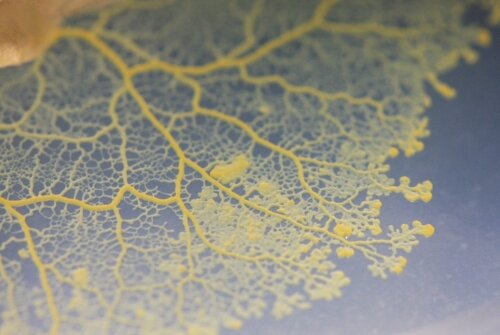Physarum polycephalum represents an enigmatic group of organisms known as the slime molds. Despite their name these organisms are not related with fungi, and form a genuine branch in the tree of life, beside plants, animals, and fungi. The uniqueness of slime molds is also shown by their biological life style and growth. Physarum polycephalum develops a richly branched network structure, also called “plasmodium”, to explore the environment for food. Despite the complex growth the plasmodium of Physarum is nothing but a gigantic single biological cell with countless cell nuclei. The mega-cell has the unique ability to move its content through the entire cellular network. Individual tubes of the network can periodically change their diameter and thereby pump the cellular plasma rhythmically back and forth through the network. The movement regularly changes direction approximately every 50 seconds. Slight variations occur when the plasmodium senses certain environmental triggers: light can slow down the rate of oscillations while potential food sources cause an acceleration of the rhythmic pace. When Physarum takes up nutrient by its surface, the plasmodium will grow but still maintains coherence of the network structure. As a result, the network architecture is highly dynamic with flexible rearrangement of its junctions, following a decentralized protocol of organization.
In nature, plasmodia form in short time and exploit the humid conditions after rainfalls or snow melt. Fungi and bacteria as main food sources are readily available under these conditions. When conditions become increasingly dry, the plasmodium creeps to the surface of the substrate where it ultimately forms characteristic fruiting structures, which sometimes resemble magically formed gems of nature. In form of the spores, Physarum survives and propagates until the whole life cycle restarts again after spore germination. As seen from the diversity of fruiting bodies and spores more than 800 slime mold species exist worldwide.

